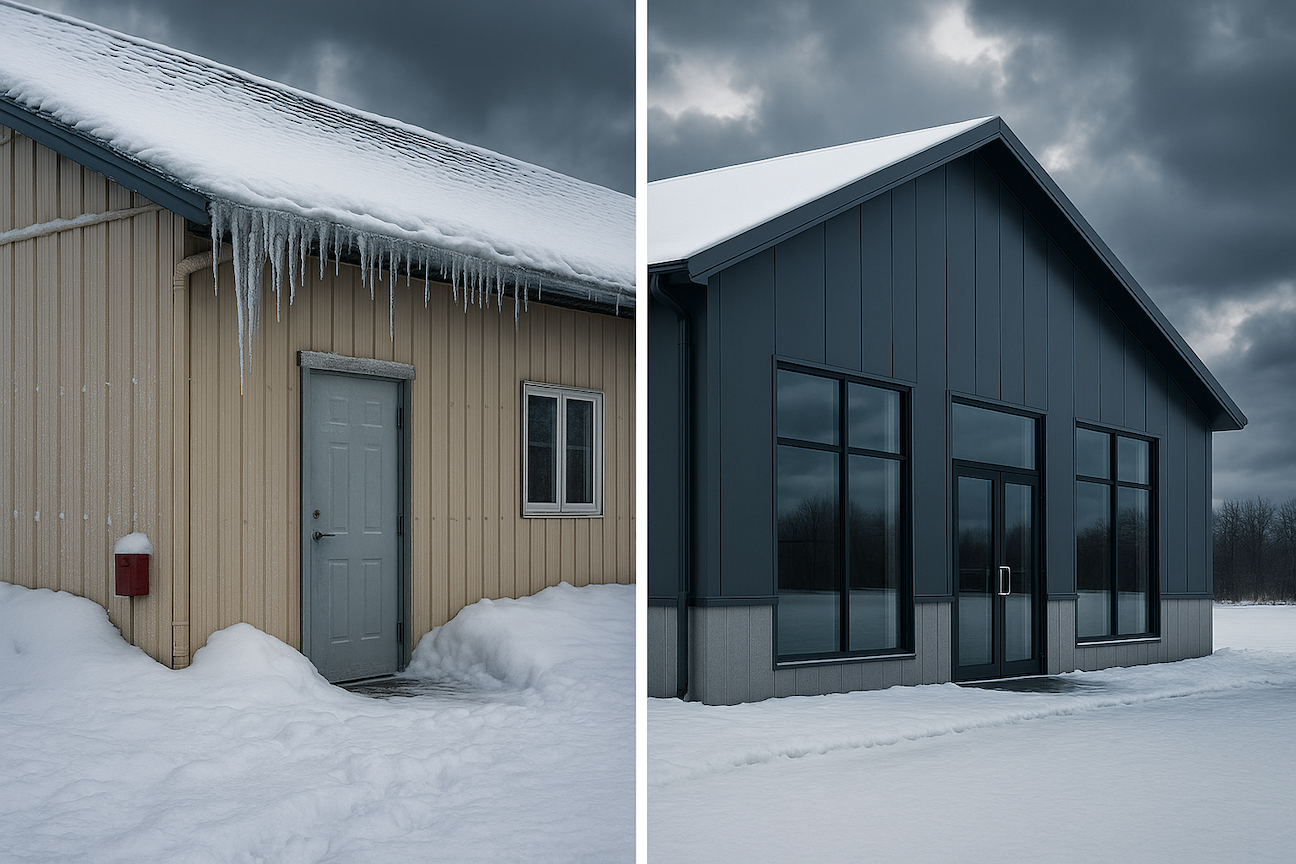
Is your building ready for winter’s worst? With temperatures already dropping and forecasts calling for a harsh winter ahead, now’s the time to take an honest look at your facility. These five warning signs could mean the difference between a smooth winter and costly emergency repairs when it’s 20 below zero.
Last winter caught many building owners off guard. Emergency repair calls spiked 300% during the polar vortex, and most could have been prevented with simple fall preparations. Don’t let your business become another winter casualty story.
Here’s what to look for, and more importantly, what you can do about it before the snow flies.
The Warning Sign: You feel cold air rushing in around doors, windows, or overhead entrances, even when they’re closed. Your heating system runs constantly, and employees complain about cold spots near entrances.
Why It’s Dangerous: Those seemingly minor drafts can increase heating costs by 25-40% and create serious comfort problems. Worse, they’re entry points for moisture that can freeze inside walls, causing structural damage and creating ice hazards around entrances.
Immediate fixes (This weekend):
Professional upgrades (Before first freeze):
Cost Reality Check: Investing $500-1,500 in door and window sealing typically saves $200-400 monthly in heating costs. The math works, especially when you avoid the emergency service calls.
The Warning Sign: You had icicles, ice buildup along roof edges, or water damage inside the building during last winter’s thaw cycles. Even small ice dams are red flags for bigger problems.
Why It’s Critical: Ice dams form when warm air heats your roof deck unevenly, melting snow that refreezes at cold edges. This creates water backup that finds its way inside, causing ceiling damage, equipment problems, and potential roof collapse from ice weight.
Urgent (Next 30 days):
The Real Cost: Ice dam removal during winter runs $500-1,500 per incident. Interior water damage can easily hit $5,000-25,000. Proper insulation and ventilation upgrades ($2,000-8,000) prevent these problems entirely.
MBMI Insight: Our cold weather steel building designs eliminate ice dam risk through proper roof pitch, continuous insulation, and integrated vapor barriers. If you’re experiencing recurring ice dam problems, it might be time to consider a building upgrade.
The Warning Sign: You see water droplets forming on walls, ceilings, or windows during cold weather. Brown stains, musty odors, or visible mold growth anywhere inside the building. Metal surfaces showing rust or corrosion.
Why It Matters: Condensation happens when warm, humid interior air hits cold surfaces – a sign that your building envelope isn’t controlling moisture properly. This leads to mold growth, equipment damage, and structural deterioration that gets exponentially worse in winter.
Immediate (Before winter):
Moisture problems don’t fix themselves… they multiply. Professional moisture control upgrades ($1,500-5,000) prevent equipment damage, health issues, and structural problems that can cost tens of thousands to remediate.
The Warning Sign: Your heating costs increased significantly last winter, or they’re already climbing this fall despite similar weather conditions. Your heating system runs constantly but the building never feels truly warm.
Why This Signals Trouble: Rising heating costs usually indicate your building envelope is failing, as heat is escaping through poor insulation, air leaks, or thermal bridging. Your heating system is working overtime to compensate for heat loss, driving up costs while failing to maintain comfort.
Assessment phase:
Upgrade options:
ROI Reality: Most building envelope improvements pay for themselves in 3-5 years through energy savings, with immediate comfort improvements and reduced maintenance needs.
The Warning Sign: New cracks in foundation walls, floor slabs, or building walls that appeared last winter or spring. Doors that suddenly don’t close properly. Windows that stick or have gaps that weren’t there before.
Why It’s Serious: These signs often indicate frost heave – soil moisture freezing and expanding, creating tremendous upward pressure on foundations. Left unchecked, frost heave can cause major structural damage requiring expensive repairs.
Critical interventions:
Don’t wait on foundation issues. Minor cracks can become major structural problems over a single harsh winter. Professional foundation winterization ($2,000-8,000) prevents damage that can cost $25,000-100,000+ to repair.
This Weekend:
Next 30 Days:
Before First Hard Freeze:
These five warning signs don’t fix themselves; they get worse every winter until something fails catastrophically. The building owners who weather winter storms successfully aren’t the lucky ones; they’re the prepared ones.
At MBMI Metal Buildings, we’ve seen too many businesses face costly winter emergencies that proper preparation could have prevented. Our engineering team has designed buildings across some of North America’s harshest climates, from Alaska to northern Maine, and we understand what it takes to create truly winter-ready facilities.
Free Winter Readiness Consultation Available
Don’t gamble with winter weather. Our experienced team can assess your building’s winter readiness and provide practical solutions that fit your budget and timeline. Whether you need simple weatherization or are considering a new building designed for extreme weather, we’re here to help.
Contact MBMI Metal Buildings today for your free winter readiness consultation. We’ll help you identify problem areas, prioritize solutions, and create a plan that keeps your operations running smoothly all winter long.
Remember: Emergency repairs in January cost 3-5 times more than preventive work in October. The choice is yours, but winter won’t wait.